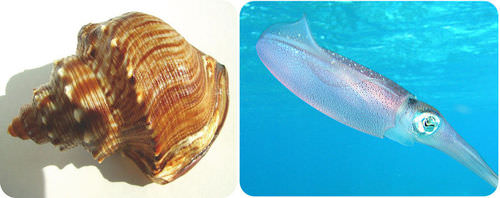9.8: Types of Mollusks
- Page ID
- 13894

What's the world's largest mollusk?
The colossal squid, one of the largest invertebrates, measures 14 feet in length here. Some of these squids are even larger and can grow up to almost 50 feet long! The smallest mollusks are snails that are microscopic in size.
Types of Mollusks
There are approximately 160,000 living species and probably 70,000 extinct species of mollusks. They are typically divided into ten classes, of which two are extinct. The major classes of living mollusks include gastropods, bivalves, and cephalopods (Figure below).
Gastropods
Gastropods include snails and slugs. They use their foot to crawl. They have a well-developed head. There are many thousands of species of sea snails and sea slugs, as well as freshwater snails, freshwater limpets, land snails and land slugs. Gastropods live in many diverse habitats, from gardens to deserts and mountains. They also live in rivers, lakes and the ocean. Most shelled gastropods have a one-piece shell that is typically coiled or spiraled, but not all gastropods have shells. Gastropods have no sense of hearing, but they can see and have a keen sense of smell. In land-based gastropods, the olfactory organs (for smell) are the most important. These are located on the tentacles.
Bivalves
Bivalves include clams, scallops, oysters, and mussels. As their name implies, they have two parts of their shell, which can open and close. Bivalves live in both marine and freshwater habitats. Most bivalves have a pair of large gills that enable them to extract oxygen from the water (to breathe) and to capture food. Water is drawn into the bivalve and washes over the gills. Mucus on the gills helps capture food and cilia transfer the food particles to the mouth. Once in the mouth, food passes into the stomach to be digested. Bivalves have a mouth, heart, intestine, gills, and stomach, but no head. Bivalves have a muscular foot, which in many species such as clams, is used to anchor their body to a surface or dig down into the sand.
Cephalopods
Cephalopods include the octopus and squid. They have a prominent head and a well-developed brain. Typically the foot has been modified into a set of arms or tentacles. Members of this class can change color. They can also change texture and body shape, and, and if those camouflage techniques don't work, they can still "disappear" in a cloud of ink. Cephalopods have three hearts that pump blue blood, they're jet powered by their muscular foot, and they're found in all oceans of the world. Cephalopods are thought to be the most intelligent of invertebrates. They have eyes and other senses that rival those of humans. Many cephalopods are active and efficient predators. What features do you think allows for this?

Summary
- Mollusks are divided into ten living classes, including the familiar gastropods, cephalopods, and bivalves.
- Mollusks live in marine and freshwater habitats, as well as on land.
Explore More
Use the resources below to answer the questions that follow.
- Mollusk Animation: Abalone Body Plan at vimeo.com/42588195 (1:22)
- Mollusk Animation: Nautilus Body Plan at vimeo.com/42588196 (2:35)
- Mollusk Animation: Squid Body Plan at vimeo.com/37431310 (1:34)
- How does the foot compare between abalone, nautilus, and a squid?
- How does the shell of an abalone differ from the shell of a nautilus?
- How many hearts does a squid have? How do these hearts help the squid?
- Describe the mantle of a squid.
Review
- Name five examples of mollusks.
- What habitats do gastropods live in?
- What is the defining feature of a bivalve?
- What mollusk is thought to be very intelligent?
- Describe the foot of a gastropod, bivalve, and cephalopod.

